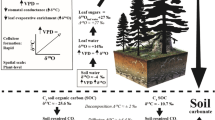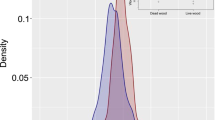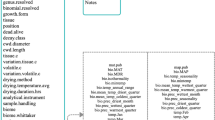Abstract
SEVERAL workers1–3 have attempted to retrieve palaeoclimatic information from the 12C/13C ratios in tree rings. Their use of whole wood, however, has been unsatisfactory, in that the extractives are isotopically much lighter than cellulose4 and vary considerably in content between heartwood and sapwood. Further, lignin is usually ∼ 3‰ lighter than cellulose and it is well known from the extensive literature on the chemistry of wood that the lignin-to-cellulose ratio varies not only across one ring, that is, in late wood as compared to early wood, but up and down and radially across the tree5. The science of dendroclimatology is based on the observation that narrow rings represent a cold (or dry) year. In most conifers the amount of late wood remains relatively constant and it is the thickness of early wood that varies. A narrow ring would be expected to have a smaller proportion of early wood than a wide ring. The different proportions of lignin in the two rings would then lead to a different isotopic ratio for the whole wood. If whole wood is used the δ13C measurements will reflect the relative proportions of lignin and cellulose. We therefore separated the lignin and cellulose from the wood before making δ13C determinations, hoping that the temperature coefficients of their production reactions might be large enough to enable the temperatures at which the carbon was fixed from the atmosphere to be measured. We also wished to investigate the possibility that the difference in δ13C between the cellulose and lignin might reflect temperature.
This is a preview of subscription content, access via your institution
Access options
Subscribe to this journal
Receive 51 print issues and online access
$199.00 per year
only $3.90 per issue
Buy this article
- Purchase on Springer Link
- Instant access to full article PDF
Prices may be subject to local taxes which are calculated during checkout
Similar content being viewed by others
References
Craig, H., Science, 119, 141–143 (1954).
Pearman, G. I., Francey, R. J., and Fraser, P. J. B., Nature, 260, 771–773 (1976).
Libby, L. M., et al., Nature, 261, 284–288 (1976).
Olsson, I. U., Klasson, M., and Abd-el-Mag eed, A., Radiocarbon, 14, 247–271 (1972).
Narayanamurti, D., and Das, N. R., Holz Roh-u. Werkstoff, 13, 52 (1955).
Barnett, J. R., Ann. Bot., 37, 1005–1011 (1973).
In Methods in Carbohydrate Chemistry (edit. by Whistler, R. L.) (Academic, London, 1963).
Keeling, C. D., Tellus, 12, 200–203 (1960).
Fritts, H. C., Tree Rings and Climate (Academic, London, 1976).
Keeling, C. D., Geochim. cosmochim. Acta, 24, 277–298 (1961).
Lerman, J. C., Proc. Coll. Int. (CNRS, Gif-sur-Yvette, 1973), 219, 163–181 (1974).
Jansen, H. S., Nature, 196, 84–85 (1962).
Author information
Authors and Affiliations
Rights and permissions
About this article
Cite this article
WILSON, A., GRINSTED, M. 12C/13C in cellulose and lignin as palaeothermometers. Nature 265, 133–135 (1977). https://doi.org/10.1038/265133a0
Received:
Accepted:
Published:
Issue Date:
DOI: https://doi.org/10.1038/265133a0
This article is cited by
-
Intra-annual tree-ring isotope variations: do they occur when environment remains constant?
Trees (2022)
-
Climate-Sensitivity Comparisons for Whole Wood, Holocellulose, and α-Cellulose Carbon Isotope Series in Masson Pine
Arabian Journal for Science and Engineering (2021)
-
Northern forest tree populations are physiologically maladapted to drought
Nature Communications (2018)
-
Site-specific climatic signals in stable isotope records from Swedish pine forests
Trees (2018)
-
Correspondence between δ13C and δ15N in soils suggests coordinated fractionation processes for soil C and N
Plant and Soil (2018)
Comments
By submitting a comment you agree to abide by our Terms and Community Guidelines. If you find something abusive or that does not comply with our terms or guidelines please flag it as inappropriate.



